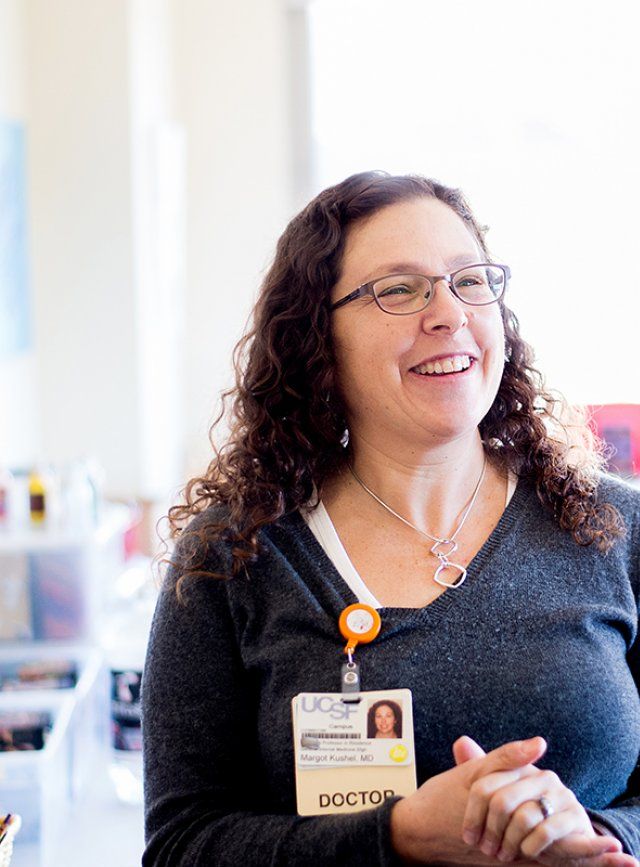This article is archived and only made available for historical reference. If you’d like to discover UCSF’s most recent advances in research, education and patient care, please visit the UCSF News Center.
Archive: To Address Homelessness Effectively, Clinicians are Learning What It Really Looks Like
UCSF Elective Course Focuses on Unique Needs of Homeless Population
Homelessness is a well-known issue San Franciscans face every day – from people panhandling on corners to tents cropping up on sidewalks to news stories about the need for more mental health services.
But the truths behind what contributes to homelessness and the specific needs of the population are less well-known.
To teach future doctors, nurses and pharmacists how they can advocate for systemic changes – for better housing policy or against de facto incarceration of the mentally ill – and how to improve their interactions with individual patients, UC San Francisco provides an elective course each fall that brings in experts to lecture on the subject.
“My experience with the course helped me understand what homelessness really looks like and has taken away a lot of the stigma and generalizations about people who are homeless,” said Megan Byers, RN, who took the Homeless Health Issues elective last year and is one of the student coordinators this year.
Inspiring Future Careers
Now in its 28th year, the student-run course brings in subject experts to speak about the structural and policy issues that contribute to homelessness and the specific needs of the population.
My experience with the course helped me understand what homelessness really looks like and has taken away a lot of the stigma and generalizations about people who are homeless.
After nearly three decades, many alumni of the Homeless Health Issues elective have become clinicians, researchers, and faculty dedicated to helping underserved populations.
That was the case for Margo Vener, MD, MPH, who launched the elective with a few classmates in 1991 after her first year of medical school. She and her peers were eager to get out of the classroom and make a difference in the community. That year, they also opened a student-run Homeless Clinic and helped advocate for homeless issues.
Now a professor of clinical family medicine and the vice chair of education for the UCSF School of Medicine, Vener says the elective really sparked her interest in working with underserved populations and in medical education. She’s now the faculty sponsor for the elective, which is geared toward first- and second-year students.
“This is that pivotal moment in a student’s career – the high impact moment. If you can provide a strong positive experience, you can engage them in their entire career,” said Vener.
Busting Homelessness Myths
Margot Kushel, MD, professor of medicine and director of the UCSF Center for Vulnerable Populations, has lectured in the course for about a decade, usually giving an overview of the structural causes of homelessness. Much of that is myth-busting. For example, Kushel said a common myth is that homeless people want to be homeless.
“When people remain homeless it’s because they have no better option, no housing, or housing that doesn’t meet their needs,” said Kushel. “And those needs are often defined by trauma they’ve been through.” It’s therefore important for clinicians to engage people in a way that is sensitive to these traumas, she said.
Many people also believe that substance use and mental health problems are the main cause of homelessness and that all homeless people suffer from these problems. Neither is the case, said Kushel.
When people remain homeless it’s because they have no better option, no housing, or housing that doesn’t meet their needs.
Margot Kushel, MDDirector of the UCSF Center for Vulnerable Populations
If we treat homelessness by not understanding what the problem actually is, we’re going to end up with the wrong solution,” she said.
Becoming Better Health-Care Providers
Byers said that understanding the barriers to accessing resources has helped her have more realistic conversations with her patients experiencing homelessness. They might not be able to take medications that require a bathroom or have transportation to appointments, for example.
It’s also important for health professionals to listen to “what people really need rather than what we think they need,” said Byers. At the Homeless Clinic, for example, when patients were asked what they would like more of, the surprising answer was foot care. Now the students are working to increase the frequency of their podiatry clinic.
Vener has seen the course evolve along with our understanding of homelessness. In 1991, the focus was on the role of the physician, whereas today there is more emphasis on broad, team-based care that includes social workers, legal aids, family and the community.
What hasn’t changed is that “UCSF continues to recruit and support a group of students who really have the desire to go out there and make a difference in the community working to care for the urban underserved, working towards health equity,” said Vener. “That’s a pretty enduring commitment over 28 years.”